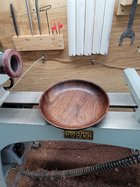I normally put a poly finish on my bowls. A friend of mine told me he made two bowls. One he put on walnut oil and then a poly finish after it dried. The other just the poly finish. He said there was a huge difference between them. I turned a walnut bowl today and didn’t have walnut oil so I used Danish oil. I will let that dry real good and then put on a poly finish. He and I both use the same poly finish. This is the bowl I made today with Danish oil.


